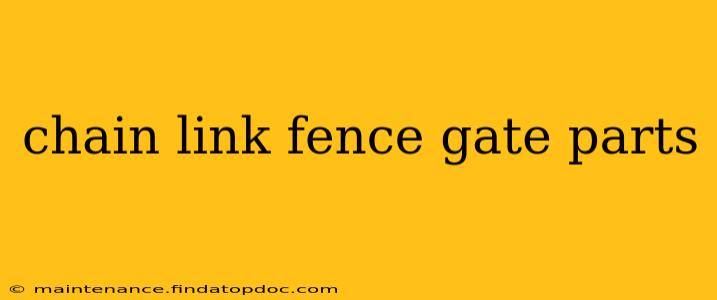Installing or repairing a chain link fence gate can seem daunting, but understanding the individual parts simplifies the process. This guide breaks down the essential components of a chain link gate, addressing common questions and providing valuable insights for DIYers and professionals alike.
What are the main parts of a chain link gate?
A chain link gate, while seemingly simple, comprises several crucial parts working in harmony. These include:
-
Gate Frame: This forms the skeleton of the gate, typically made of galvanized steel or aluminum. It's usually rectangular or square and provides the structure for the chain link fabric. The frame's strength is paramount for gate durability and longevity.
-
Chain Link Fabric: This is the woven wire mesh that's stretched and attached to the gate frame. The fabric's gauge (thickness of the wire) determines its strength and resistance to damage.
-
Gate Posts: These support the gate and are typically larger and sturdier than the fence posts. They're either set in concrete or utilize a specialized anchoring system. The posts need to be properly aligned and secured for the gate to function smoothly.
-
Hinges: These connect the gate frame to the gate posts, allowing the gate to swing open and closed. Hinges should be strong and well-lubricated for smooth operation and to prevent wear and tear.
-
Latch: This secures the gate in the closed position. There are various latch types available, from simple hooks and eyes to more secure locking mechanisms.
-
Gate Hardware: This includes various fasteners, such as bolts, screws, and clips, used to assemble and secure the gate frame, fabric, and hinges. The quality of your gate hardware significantly influences the gate's lifespan and security.
-
Closer/Spring (Optional): Some gates incorporate a spring closer or other self-closing mechanism that automatically pulls the gate shut after it's opened. This adds convenience and enhances security.
What are the different types of chain link gate latches?
Various latches cater to different security needs and aesthetics. Common types include:
-
Hook and Eye Latch: This is a basic, inexpensive option, often sufficient for low-security applications.
-
Spring Latch: A more secure option that springs closed automatically, providing added convenience and security.
-
Padlock Latch: This allows for additional security by incorporating a padlock, ideal for higher-security areas.
-
Self-Closing Latch: These latches combine a latch mechanism with a spring, automatically closing the gate after it's opened.
The choice of latch depends on your specific needs and budget.
How do I repair a chain link gate?
Repairing a chain link gate often involves addressing specific broken or damaged parts. This might include:
- Replacing a broken hinge: This usually involves removing the old hinge and securing a new one using the existing hardware.
- Replacing the chain link fabric: If the fabric is significantly damaged, it may need replacement, a process that can be more involved but is often feasible for DIYers.
- Tightening loose hardware: Regularly checking and tightening any loose bolts or screws prevents damage and ensures the gate's security.
- Replacing the latch: A broken or malfunctioning latch can easily be replaced.
Where can I buy chain link gate parts?
Chain link gate parts are widely available at various retailers, including:
- Home improvement stores: Major retailers often carry a range of parts, from basic hinges and latches to complete gate kits.
- Fence supply companies: Specialized fence suppliers typically offer a wider selection of parts and may offer expert advice.
- Online retailers: Online marketplaces provide a broad selection, allowing you to compare prices and find specific parts easily.
This detailed overview of chain link fence gate parts equips you with the knowledge needed to understand, repair, or install your gate effectively. Remember to always prioritize safety when working with tools and ensure proper installation for optimal performance and longevity.
